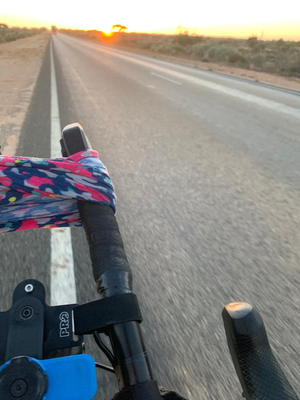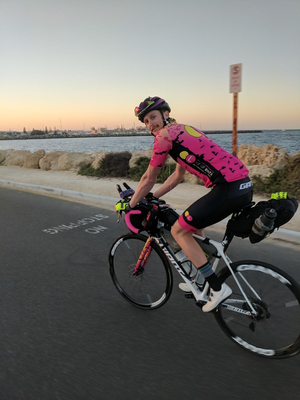
A trip from Fremantle to Sydney is quite a journey, but Berwick’s Matt Lockhart cycled the challenging route, as DANIELLE KUTCHEL and STEVEN HAYLOCK report.
“It was hard when I got into Melbourne and saw all my friends and family and then had to ride off on them!”
“I just wanted to see if I could do it.”
That’s the whim that kicked off Matt Lockhart’s epic adventure across the continent back in March – an adventure of thousands of kilometres, a “fair bit” of road rage and intense mental and physical fatigue.
As a competitor in the Indian Pacific Wheel Race, the 27-year-old Berwick resident journeyed from Fremantle to Sydney via Adelaide, Melbourne and Canberra, solo and unsupported.
This was his first attempt at the race and a personal challenge he gave himself after learning of the event through cycling friends.
It’s a trip that looks long on a map, and it is long – including a stint across the featureless Nullarbor.
The event is not without danger: a few years ago one cyclist, Mike Hall, was struck by a car and killed on the final leg of the trip.
Mr Lockhart says Mr Hall’s death was not far from his mind as he traversed the same stretch of road.
“It was a constant reminder of being alert, I was thinking about him the whole way across that section,” he said.
There were other difficulties to confront too. Mr Lockhart trained for a targeted 18 months for the event to try and prepare for the physical and mental demands he knew he would face. Although there were lots of long solo weekend rides to prepare him for being on his own for so many weeks, the lack of stimulation from a plain environment, along with being away from family and friends and the knowledge of the length of the journey formed a sort of roadblock early on for the cyclist.
“It definitely got lonely,” Mr Lockhart recalls.
“It was hard when I got into Melbourne and saw all my friends and family and then had to ride off on them!
“But the first week was very mentally challenging. Six days of constant headwinds from Fremantle pretty much all the way to Adelaide, and long flat straight roads with not much mental stimulation on the Nullarbor, made it a very tough week to get through mentally.”
As the ride progressed, he says his mood changed slightly.
“It doesn’t matter how fast you go as long as it’s in the right direction. By the last week you feel like you’re getting somewhere and it gets a little easier.
“But getting on the bike each morning is challenging – you don’t want to be there.”
To stave off the loneliness he would call his cycling buddies, family and partner.
He also spent much of the ride listening to music, but found that when things got really hard he needed to switch tactics.
“I’d focus on something else, or try to hear birds, but a lot of time you’re just not enjoying it so you’re almost angry. I did find just yelling or screaming, letting out a burst of energy, was good to let that go and then it let you refocus on trying to think about something else.”
While the ride is solo, that’s not to say there isn’t any support. The event is followed online by dedicated ‘dot watchers’, who track each cyclist’s movements via GPS trackers that appear as dots on a map. Often these dot watchers come out in person on the route to say hello and offer food and drink to competitors.
“That’s as close to support as we get,” Mr Lockhart says.
“I was getting a lot of messages via Instagram and Facebook as well that I’d stop and read while at a town having a feed. The messages are definitely motivating. When you read stuff like that, it’s a reason to get back on and keep rolling.”
With no support vehicles and no set stops, riders are left to their own devices to negotiate the highways and, while sticking to the predetermined route, competitors can choose where and when they eat, rest or sleep on this independently run event. Hotels were the only luxury; when sleep was required between towns – day or night – his ‘Bivvy Bag’ (a swag-like sleeping cover) was his bed off to the side of the road. When crossing the Great Australian Bight, Mr Lockhart slept during the heat of the day and pushed pedals through the windiest section of road at night.
The large freight trucks were clearly visible well before passing him and highlighted the vast flat sections of the Nullarbor.
“I timed it one night, I could see the headlights of a road train approaching 38 minutes before it passed me,” Mr Lockhart says.
The Aussie wildlife proved to be an unlikely source of motivation at one point.
“When I was riding across the 90 Mile Straight, doing it overnight to get out of the heat, I saw four or five dingoes and because I was so mentally fatigued I thought they were chasing me! I was running from dingoes for about an hour,” Mr Lockhart says.
“It was at night so you don’t know if you’re going faster but it felt like it. The heart rate went up a bit!”
The 90 Mile Straight also offered another of his most memorable moments.
“It was right at the start at the west end sign, 11.30 at night, and there just happened to be six of us doing the same event there. We were just standing there taking photos at this sign, and it was the oddest moment because were all from different corners of Australia and the world, and all standing around in lycra in the middle of the Nullarbor eating chocolate bars and taking photos!
“It’s one of those memories I’ll never forget.”
Mr Lockhart rode at an average pace of 275 kilometres a day. The longest distance he cycled in one day was 360 kilometres, an enormous feat considering he had ridden over 300 kilometres on the previous two hilly days, utilising every one of his 22 gears.
“I was aiming to do the ride in around 22 days, I thought that would be fairly achievable,” he recalls.
Headwinds early on put him behind schedule before he managed to get ahead again after a good run through Melbourne. He finished in 20 days and six hours, coming fourth out of 22 race starters.
“My proudest moment was finishing. It’s very emotional, that last half a day. You can’t really believe you’ve finished it.”
Personally, Mr Lockhart says he learned a lot about the power of his mind and body.
“Physically, you feel like you’re in a hole and can’t do it, but if you shut everything out and think about the basics and keep rolling, it all just happens. I couldn’t believe my body let me do that!”
Riding to Bondi Beach after the official finish at the Opera House was a heartfelt ending to an epic ocean-to-ocean ride. Mr Lockhart dipped his front wheel in the Pacific Ocean as per race tradition and felt an immense sense of achievement.
Too tired for a big party, he celebrated with a quiet beer and is currently still in recovery, although contemplating taking on the trek from Cape York to Wilson’s Promontory in future.
Mr Lockhart says his journey was definitely a life-changing experience.
“You come back a little bit different. You go back into primal instincts: get up, eat, ride, eat again, sleep. I just really enjoyed that basic aspect of life.”








